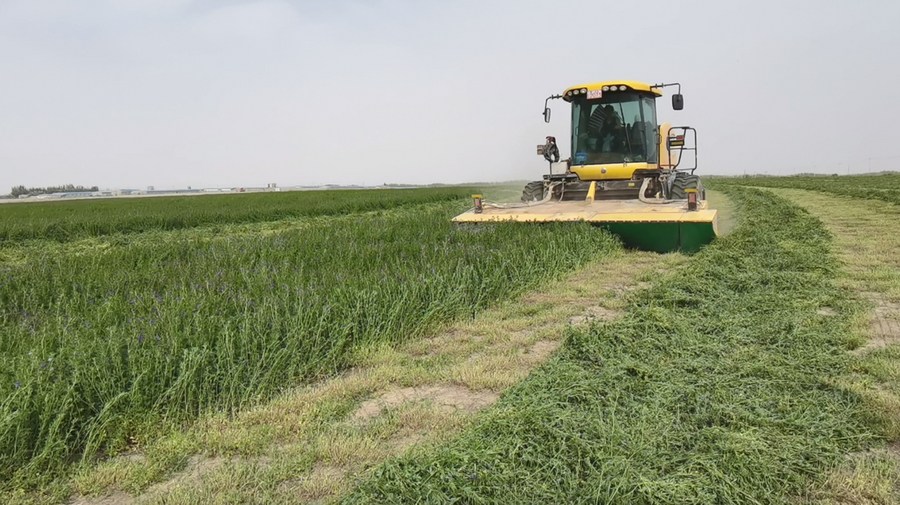Updated: June 16, 2023
In the intense heat of early June in Hotan, Xinjiang, Wang Zhixiang, a researcher from Chongqing Jiaotong University (CQJTU), walks through the “Desert Soilization” experimental site on the outskirts of Hotan County. The alfalfa field before him, harvested for the first time this year in late May, has already regrown to over 30 centimeters tall. He eagerly anticipates the second harvest in a month.

This photo taken on May 23, 2023 shows an agricultural machine harvesting at a "desert soilization" base in Hotan Prefecture, northwest China's Xinjiang Uygur Autonomous Region. [Photo/Xinhua]
World Day to Combat Desertification and Drought is observed annually on 17 June to promote public awareness of international efforts to combat desertification. Desert ecological restoration remains a significant challenge for many countries. Yet, in China’s Taklimakan Desert in Xinjiang and the Ulan Buh Desert in Inner Mongolia, vast expanses of lush farmland thrive against the odds.
In the desertified grasslands of Ruoergai, Sichuan, the arid outskirts of Lhasa, Tibet, and the sandy isles of the Xisha Islands, vegetation and even vegetables have sprouted—thanks to the “Desert Soilization” technology developed by a research team led by Yi Zhijian.
Professor Yi Zhijian from CQJTU is a mechanician. In 2009, while studying the mechanics of granular materials, he discovered that the transition of granular materials from a discrete state to a rheological state and then to a solid state relies on an omni-directional integrative constraint relationship.
“At the time, I noticed that the key difference between soil and sand lies in the presence or absence of this constraint,” Yi said. “When it dawned on me that this discovery could turn sand into soil, I was so excited that I couldn’t sleep!”
Yi Zhijian’s team proposed an original mechanical principle: soil particles are bound by an omni-directional constraint. When soil particles achieve this constraint, they can retain water and nutrients while allowing air permeability, creating an optimal environment for plant growth. At the same time, they are able to stabilize plant roots. For the first time, Yi’s team established a connection between the mechanical properties and ecological attributes of soil.
In 2013, the team developed a water-based paste that, when mixed with sand and an appropriate amount of water, enables the sand to acquire the eco-mechanical properties of natural soil. It behaves like mud when wet and solidifies when dry, seamlessly transitioning between these states. Additionally, it retains water, nutrients, and air effectively, providing an ideal medium for plant growth.
Since 2016, the “Desert Soilization” technology has been successfully applied in diverse landforms and climates, both China and abroad, covering more than 30,000 mu (approximately 2,000 hectares).
In the middle of the Ulan Buh Desert, drought tolerant plants in the experimental site can grow naturally without additional irrigation, forming an natural barrier. The water used for irrigation is well below local agricultural and pastoral water allocation limits. Tests conducted by authoritative institutions confirm that both the paste and “soilized” sand fully comply with national environmental standards. Moreover, more than 10 agricultural products grown using this technology have received China’s green food certification.
From an economic perspective, desert “soilization” is highly cost-effective. Due to the low content of constraining material and the simplicity of the preparation method, the total cost ranges from 4,500 to 6,500 dollars per hectare, depending on planting requirements. Over time, “soilized” sand continues to improve, fostering a rich microbial population, enhancing biodiversity, and gradually benefiting local climate conditions. The technology is easy to implement, works quickly, and requires only a one-time application of the paste. It supports large-scale mechanical cultivation, stabilizes sand immediately, and enables planting soon after “soilization,” seamlessly integrating sand fixation with ecological restoration.
Through continuous field experiments in recent years, this cross-disciplinary innovation has gained international recognition. In December 2022, the “Desert Soilization” technology won the Protect and Restore Nature award under the Earthshot Prize spearheaded by Prince William, and was recognized as “Desert Agricultural Transformation.”
This year marks the 10th anniversary of China’s vision for building a community with a shared future for mankind. In tackling the global challenge of desertification, Chinese scientists are working tirelessly to achieve breakthroughs, and China’s innovative technologies are extending support to countries in need.
Source: Xinhua Net:中国科学家发现沙漠变土壤“密码”-新华网
Related link: Sci-tech innovation turns desert sands into arable land - People's Daily Online